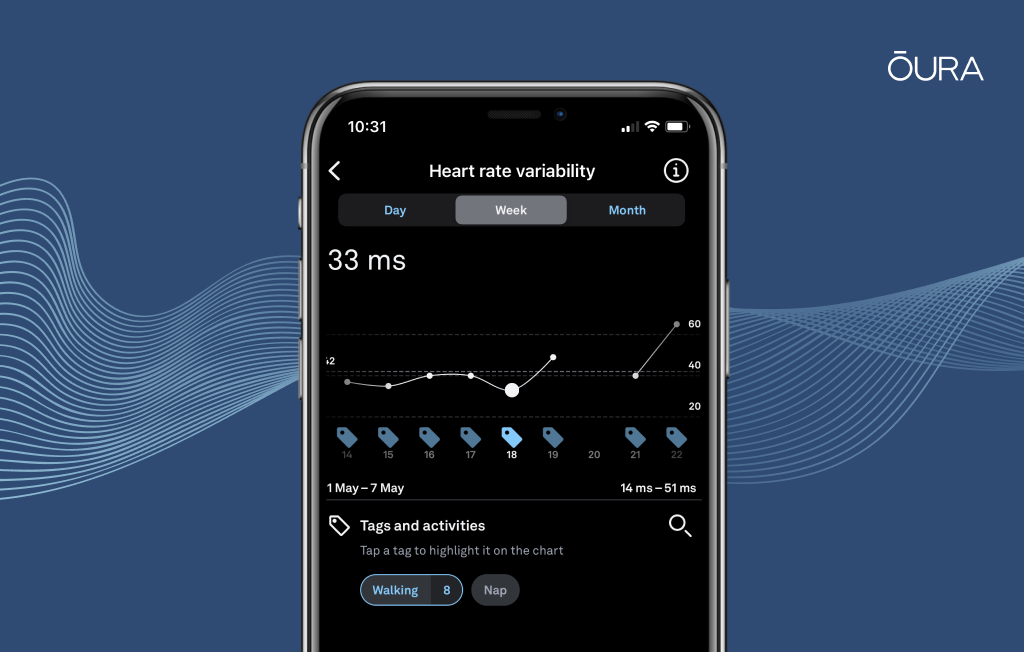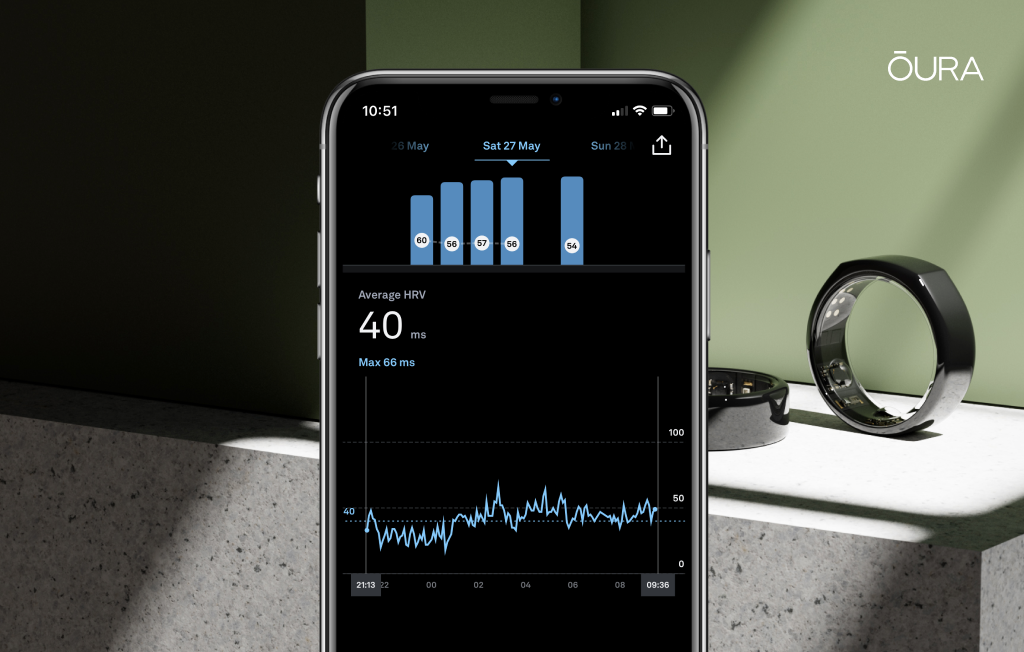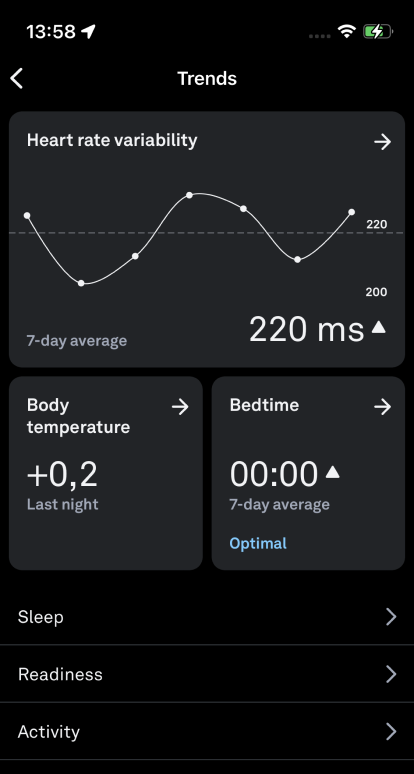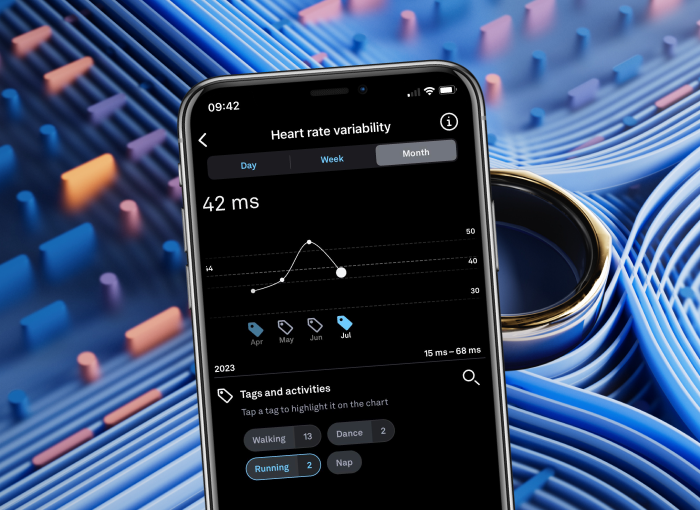- There’s a strong correlation between HRV and stress: while a lower HRV (heart rate variability) may signal stress, both mental and physical, a higher HRV can signal your body is well rested and recovered.
- Through your HRV metrics, you may notice signs of either acute (short-term) or chronic (long-term) stressors, such as an illness, lifestyle changes, alcohol consumption, or longer term sources of mental stress.
- Using a wearable like Oura can help you understand your HRV trends over a long period of time, helping you understand how your body reacts to and recovers from different sources of stress.
One of the strongest physical indicators of stress is heart rate variability — or HRV. This biofeedback marker provides insight into the state of your autonomic nervous system, or ANS.
As a general rule of thumb, a higher HRV value reflects relatively low stress levels, while a lower HRV may signal higher stress. However, “high” and “low” are relative terms, as your baseline HRV is as unique as your fingerprint. It can be as low as 20 or as high as 200 milliseconds.
RELATED: What Is the Average HRV of Oura Members?
Oura’s HRV Measurements
Monitoring your HRV with a wearable like Oura over time can provide clues about your physical and mental health. That’s why HRV is one of the contributors to your daily Readiness Score in the Oura App, which tells you how primed your body is for the day ahead. Oura members can also track their long-term HRV data in the Trends tab to monitor their stress levels over a period of time.
Plus, Oura’s measurements of HRV have been shown to be highly accurate, according to a 2020 study. Specifically, when compared to a medical-grade ECG device, the Oura Ring showed extremely high agreement for heart rate variability (r² = 0.980).
READ MORE: How Accurate Are Oura’s Heart Rate & HRV Measurements?
How Does HRV Signal Stress?
HRV refers to the fluctuations of rhythm that occur with every heartbeat, enabling you to respond to different stressors in your life. When you face a stressful situation, your HRV lowers. Once the stressor passes, your HRV should return to within its normal range. However, many people face chronic stress, which can suppress your HRV.
Over a long period time, a lower-than-baseline HRV may also lead to physical health issues, including diabetes, heart disease, and high blood pressure, and mental health problems, such as depression and anxiety.

To better understand the link between HRV and stress, it’s important to understand how the ANS works. The ANS has two main parts: the sympathetic nervous system (SNS) and the parasympathetic nervous system (PNS), and each is responsible for the physiological responses that occur when you face different types and levels of stress.
The SNS activates your fight-or-flight response, and it kicks into action when you sense danger or a threat. It increases your heart rate and blood pressure while concentrating blood flow away from the internal organs and directing it toward your limbs in preparation to fight or flee.
On the other hand, the PNS is the rest-and-digest — or relaxation — response. It slows your heart rate, lowers your blood pressure, and returns blood to your internal organs, promoting digestion and rest.
READ MORE: How Stress Affects Your Sleep
Generally, a higher HRV is associated with the PNS and lower HRV with the SNS, but since “high” and “low” are relative, the best way to monitor your HRV is to use a health wearable like Oura for a few weeks or months. This will allow you to compare your HRV score to your average and identify what activates and deactivates your SNS and PNS — providing valuable data about your mental stress levels.

Different Types of Stress & Their Effects on HRV
Different types of stressors can have varying effects on HRV. Acute stressors that are brief and intense can lead to a brief decrease in HRV. Examples include exams, a high-pressure deadline, traffic accidents, or public speaking anxiety.
Once the situation is resolved, the stress diminishes, and your HRV returns to baseline. The brief decrease in HRV is a sign that your body is responding to the stressor and your ANS is functioning correctly. It is temporary and will return to normal once the stressor has passed.
Meanwhile, exposure to chronic stressors like unresolved trauma, grief, or chronic illness can also result in reduced HRV. When you’re chronically stressed, your SNS goes into overdrive because your stress response is constantly activated, inhibiting your body’s ability to bounce back.
Chronic or prolonged stress can reduce your average HRV over time by continuously activating the SNS, disrupting the balance between your stress and relaxation responses.
How to Detect Stress by Monitoring Your HRV
HRV monitoring can help you track how your HRV changes over time, providing insights into the state of your nervous system. It can reveal how your body responds to both external stressors and internal factors such as your thoughts, emotions, and feelings. While your doctor can order an electrocardiogram (ECG) to measure your HRV, the easiest way to track it is with a wearable device like Oura Ring.
Here are four ways you can use your Oura HRV data to detect stress:
1. Establish Your Baseline
After a few weeks of wearing your Oura Ring, the Oura App will establish your baseline HRV. Once you know your baseline, you’ll be able to detect any significant variations.
2. Identify Which Lifestyle Factors Impact Your HRV
HRV monitoring allows you to observe your HRV patterns during certain situations. Being aware of which lifestyle factors or changes impact your HRV can help you figure out the cause, and take steps to reduce the effects of stress.
Examples of situations that cause significant deviations from the baseline HRV include:
-
- Illness or injury: During periods of illness or injury, you may notice lower HRV while your body recovers from physical stress.
- Lifestyle changes: Significant changes in sleep patterns, exercise routines, or diet can affect your HRV. For example, if you adopt a new exercise regimen, it may alter your HRV measurements because exercise puts your body under stress.
- Alcohol: Alcohol puts your body under stress, causing a higher resting heart rate and lower HRV. An analysis of Oura member data revealed that, after drinking alcohol, 70% of people experienced a reduction in HRV, and the median decrease was 12.1%.
- Chronic stressors: When a stressor is present for an extended period, it’s considered chronic. This may include physical or mental health conditions, such as cardiovascular disease or anxiety disorder, or external factors, such as the death of a loved one.
- Different times of your menstrual cycle: A 2020 meta-analysis found that HRV decreases significantly during the second half of the menstrual cycle.
RELATED: Why Am I So Tired on My Period?
3. Stay On Top of Daily Stress Management

Everyone goes through stressful moments in life. Some are momentary — like giving a presentation at work — and others last longer, for example, life transitions like moving or getting divorced.
Understanding your baseline HRV and which stressors affect it the most can help you take steps to manage stress in your daily life, incorporating activities that activate the PNS and give your body and mind a break from stress.
Stress management techniques to consider adding to your routine include:
- Meditation: Numerous studies have shown that meditation can have a positive effect on HRV. Use the guided meditations among the Explore content of the Oura App to relieve stress and receive biofeedback data after every session.
- Take a green walk: Studies have shown that “green walks” — i.e., walking in nature or green suburban areas — improve HRV responses. One 66-year-old Oura member doubled his HRV by switching late-night gym sessions for gentle evening walks.
- Hit the mat: Similarly, yoga has been shown to activate the PNS and increase HRV.
- Just breathe: One study found that practicing resonance frequency breathing (slow breathing at around three to seven breaths per minute) improved HRV parameters in participants.
RELATED: 10 Simple Breathing Exercises for Sleep and Relaxation
 4. Track Your Long-Term Trends
4. Track Your Long-Term Trends
Tracking your HRV with Oura’s Trends feature over a chosen period of time — weekly, monthly, or even yearly — enables you to identify long-term trends and patterns related to stress. It can reveal whether your stress levels are consistently high or if certain periods or events impact your HRV. Armed with this data, you’ll be better equipped to manage your stress.




